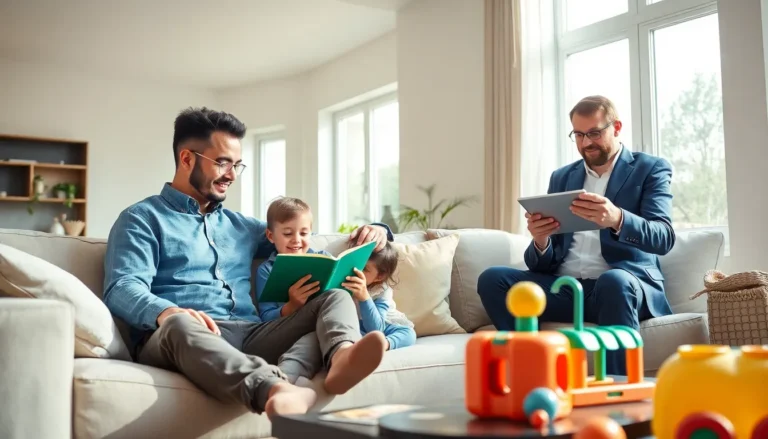Table of Contents
ToggleIn a world where sharing memories is just a tap away, it’s frustrating when those cherished iPhone photos refuse to play nice. Ever tried sending a photo and ended up with a mysterious HEIC file? It’s like sending a birthday card that only your pet understands. Fear not! There’s a way to convert those pesky files into good ol’ JPEGs, making sharing a breeze.
Understanding JPEG Format
JPEG, or Joint Photographic Experts Group, represents a widely accepted image format. This format efficiently compresses images, maintaining quality while reducing file size. Many devices and applications use JPEG for sharing and viewing photographs.
Compression techniques applied in JPEG minimize file size dramatically. A typical JPEG image can lose some quality but retains essential details, making it suitable for everyday use. When compared to HEIC, JPEG files generally enjoy broader compatibility across platforms and devices.
JPEG supports a color depth of up to 24 bits, allowing for millions of colors. This richness in color is vital for photographers and casual users who aim for vibrant images. Additionally, JPEG supports various resolutions, ensuring that images look sharp on screens of different sizes.
When sharing images via email or social media, JPEG’s compatibility shines. Most platforms prioritize this format, ensuring hassle-free sharing experiences. Users can send images without worrying if recipients can view them.
Beyond sharing, JPEG features simple editing capabilities. Many software programs and apps offer tools to enhance or modify JPEG images, making this format versatile for creative projects. Knowing how to work with JPEG images can make photo management easier.
Overall, in various contexts, JPEG remains a go-to choice for image sharing and storage, contributing to a smoother transition from HEIC files.
Changing iPhone Settings

It’s essential to adjust your iPhone settings to send photos as JPEG files instead of HEIC. Simple adjustments can ensure smoother photo sharing across platforms.
Adjusting Camera Settings
Adjust the camera settings on the iPhone to capture images in JPEG format. Navigate to Settings, tap on Camera, and then select Formats. By choosing the most compatible option, this configuration allows for immediate usage of JPEG files rather than HEIC. Doing this makes exporting photos easier when sharing with friends or posting online.
Modifying Photo Format
Modify the photo format for existing images by selecting the desired photo and choosing the Share option. Tap on Save as JPEG in the sharing menu if this option appears. This process converts specific HEIC images to JPEG instantly. Utilizing third-party apps also aids in batch conversion, speeding up the transition from HEIC to JPEG for multiple photos at once.
Sending Photos via Email
Sharing photos via email becomes a straightforward process when converting them into JPEG format. This method ensures compatibility across various email clients and devices.
Using the Mail App
The Mail app makes sending JPEG photos simple and efficient. To share an image, open the Photos app and select the desired photo. After selecting, tap on the Share icon and choose Mail from the options. It’s crucial to check that the photo is in JPEG format; otherwise, the HEIC format remains. If the email needs small attachments, consider compressing the image size without sacrificing quality. Recipients will receive a clear JPEG file, ensuring that everyone can view the photo without compatibility issues.
Using Third-Party Email Clients
Third-party email clients also offer a seamless photo-sharing experience. Users can upload their photos directly from the Photos app. Open the desired photo and tap Share. After selecting the third-party email client, the JPEG format usually transfers automatically. Some apps allow settings adjustments to ensure images always send in JPEG format. When sending multiple images, these clients may offer batch sharing options, enhancing convenience for users needing to share several photos at once. The flexibility provided by these applications improves the overall process of sharing JPEG images.
Sharing Photos via Messaging Apps
Sharing photos via messaging apps becomes straightforward with JPEG format. JPEG ensures compatibility across platforms and maintains image quality for seamless viewing.
Using iMessage
iMessage automatically converts HEIC files to JPEG when sending images. Users can select a photo in the Photos app, tap the share icon, and choose iMessage. The recipient receives the image in JPEG format, ensuring it displays correctly on their device. By default, iMessage handles image resizing, optimizing each file for faster delivery without compromising quality.
Using Other Messaging Platforms
Other messaging platforms also support JPEG images effectively. Applications like WhatsApp and Facebook Messenger typically convert HEIC files to JPEG during the sending process. Users simply select images from their gallery and send via the chosen app. Size restrictions might apply, so keeping file sizes within limits ensures successful delivery. This automatic conversion improves cross-platform sharing experiences, allowing friends and family to enjoy images without technical difficulties.
Transitioning from HEIC to JPEG can greatly enhance the experience of sharing iPhone photos. By adjusting settings and utilizing built-in features or third-party apps, users can effortlessly convert and send images in a widely compatible format. This not only ensures recipients receive high-quality photos but also simplifies sharing across various platforms. Embracing JPEG for photo sharing allows for a seamless experience whether sending via email or messaging apps. Adopting these practices will make sharing memories easier and more enjoyable for everyone involved.





